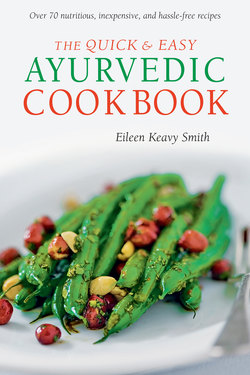Читать книгу Quick & Easy Ayurvedic Cookbook - Eileen Keavy Smith - Страница 7
ОглавлениеPREFACE
Several years ago, I read a book about Ayurveda that explained very clearly why and how our health and enjoyment of life are affected by all sorts of influences. Ayurveda (pronounced eye-your-vay’-dah) is a Sanskrit word meaning “the science of life.” The holistic Ayurvedic tradition has its roots in ancient India, and is gaining popularity in the West as we learn of its benefits. Ayurveda teaches that these influences, such as food, tastes, odors, the weather, music and other sounds, physical exercise, and much more can affect people in different ways, depending upon each person’s individual constitution. For instance, I learned why I can’t tolerate a blast of direct air from an air conditioner, while others find it refreshing. I learned interesting and useful things about eating and health, such as why I have problems with heartburn during the summer, but have virtually no heart-burn during the rest of the year. Ayurveda goes even further by recommending how an individual can modify these influences to suit his or her own constitution. A self-test will help you determine your Ayurvedic constitution (page 8).
This cookbook is the result of having organized my meals according to Ayurvedic principles. My main objective is to keep meal planning and cooking as simple as possible. I am a busy American woman with a full-time job. I don’t have time to hunt for unusual ingredients or to spend hours every day making complicated recipes from scratch. Several Ayurvedic cookbooks are listed in the Resources section of this book. All recipes in these cookbooks are vegetarian, and some of them call for ingredients that are hard to find. I enjoy using these cookbooks from time to time, but find them impractical for daily use. So, I have adapted my favorite, easily prepared recipes to fit the basic rules of Ayurvedic cooking and eating.
As you read and use this book, please keep in mind not just the Ayurvedic principles that it teaches you, but also some universal nutrition principles of which you are, most likely, already aware. The first step to practicing Ayurvedic principles is to join the increasing number of consumers who are enjoying more fresh, locally grown, organic foods. Ayurveda is all about being in tune with nature, and the movement toward eco-friendly agriculture and “green” consumerism is a hopeful sign that our society is moving in a more Ayurvedic direction. Second, try not to sacrifice your health and well-being for the sake of time-saving convenience. While it occasionally may be necessary to stop at a fast food restaurant, or use canned or frozen foods instead of fresh, try not to make this your norm. (However, when you do use canned or frozen food, use organic brands!) Third, remember to balance good nutrition with adequate physical exercise. Even when you eat healthy food, it’s still possible to overeat—to take in more calories than you expend in movement—and therefore to become overweight.
The information about Ayurveda in this book is very basic. If you would like to know more about the subject, several excellent books are listed in the Resources section, along with the names, addresses and phone numbers of three Ayurvedic organizations located in the United States. I have provided a general description of what Ayurveda is, how it relates to food, and what can be eaten to help relieve some common occasional ailments. As with any ailment, if symptoms persist or worsen, a physician’s opinion should be sought.
I hope that my friends and other readers will enjoy learning about Ayurveda and how to apply it to meal planning and cooking. I celebrate the unfolding of optimal health and wellness in all of us!
